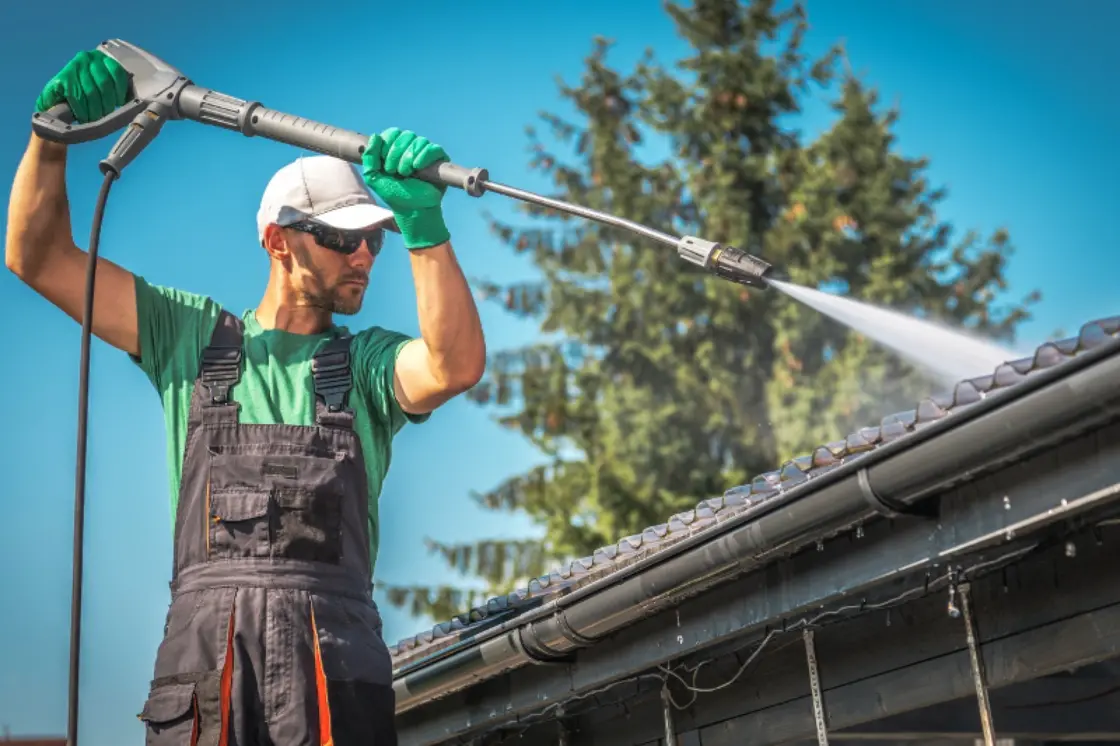How to Pressure Wash Gutters: Step-by-Step Gutter-Cleaning Methods

It’s time to clean out your gutters, but you’re not sure how to do it, and you’d rather not spend a lot of time on this unsavory chore.
The good news? You can save yourself from having to worry about cleaning out your gutters again if you choose LeafFilter Gutter Protection. It comes with a clog-free guarantee, which means your gutters will be maintenance-free.
Have you cleaned out your gutters yet? We didn't think so! Schedule your free estimate today and let our team do the rest by visiting https://t.co/4bLZOBDHja #LeafFilter #DebrisFree pic.twitter.com/wgfa3c90EW
— LeafFilter Gutter Protection (@LeafFilter) June 21, 2023
If you have to clean out your gutters—a wise decision with most systems—learning how to pressure wash gutters is one of the best ways to do it.
In this article:
- Why Use a Pressure Washer?
- The Tools You’ll Need to Clean Out Your Gutters with a Pressure Washer
- Step-by-Step Instructions to Clean Out Your Gutters with a Pressure Washer
- Preventing Clogs Inside Your Gutters
- Frequently Asked Questions
Why Use a Pressure Washer?
For starters, as long as you have the right tools, using a pressure washer means you can safely clean out your gutters from the ground. This saves you the risk of having to climb a ladder. According to the American Academy of Orthopedic Surgeons, 500,000 people are treated every year for ladder-related injuries, with about 300 of these proving to be fatal.
Also, a pressure washer has the power to burst through any clogs that may have formed inside your gutters over the past several months. This can help the water flow freely, keeping your home safe from any potential water damage clogged gutters can cause.
Lastly, using a pressure washer allows you to get the job done more quickly than you might with other methods. In most cases, once you know what you’re doing, you can finish a standard-sized gutter system in about an hour.
The Tools You’ll Need to Clean Out Your Gutters with a Pressure Washer
Although using a pressure washer can make cleaning out your gutters easier and more efficient, you’ll first need to ensure you have the right tools. Using the wrong tools in the wrong way can do more harm than good.
Pressure Washer
Start with a gas- or electric-powered pressure washer. It’s best to use one that has a pressure rating of between 1,500 and 1,800 psi, as this will give you enough power to clean out your gutters and remove clogs, but not so much that you’ll weaken or break your gutters.
Powerful pressure washers that offer over 3,000 psi can cause structural damage to your gutters and perhaps even your roof. Too much pressure can also loosen the granules on the shingles, which can then flow into your gutters. Use caution and start with a low-pressure wash.
Telescoping Wand
In most cases, you’ll need a telescoping wand to reach inside your gutters. These usually extend from eight to 24 feet. This is an important tool, as it can save you from having to climb a ladder.
Gutter-Cleaning Wand
This is the curved attachment for the end of your pressure washer or telescoping wand, and it allows you to access the gutters from the ground. These are easy to find at home-improvement stores or on Amazon.
Cleaning Materials
These include detergent to put into the pressure washer, and tarps or drop cloths to protect flower beds and other sensitive areas from falling debris. You may also need a gutter trowel or scoop to loosen any clogs in your downspouts, and a bucket for your detergent solution (if your pressure washer doesn’t have a detergent tank).
Safety Equipment
Debris will fly out of your gutters as you clean them out, so you’ll want to shield your eyes, and as much of your skin as you can, to avoid getting hit.
A hat, safety glasses, and a long-sleeved shirt and pants are important, and you should also consider ear protection. Most pressure washers are noisy, and hearing damage is non-reversible.
Step-by-Step Instructions to Clean Out Your Gutters with a Pressure Washer
Now that you have your tools at hand, you’re ready to begin cleaning out your gutters.
1. Inspect Your Gutters
If any of your gutters are leaking or showing signs of wear or breakage, you’ll want to repair them before blasting them with a pressure washer. The force of the rushing water can exacerbate any problems that are already there, potentially causing further damage.
That means you can save time and money (not to mention hassle!) by making sure your gutters are in good shape first.
Calling a gutter repair company to fix any problems is typically preferable to trying to fix the damage yourself. That way, you won’t have to climb a ladder to patch the leak yourself.
If you decide to do your own repairs, be sure to make ladder safety a priority. Use a silicone sealant to fix any leaky joints, and adhesive patches for small holes. Replacing the spikes can help repair any loose gutters.
2. Clear the Area
Before you start, clear out any sensitive materials around the perimeter of your home. This includes flower pots, outdoor furniture, cars and other vehicles, and anything else that may be harmed by falling debris. You also want to make sure the area is clear of any tripping hazards.
3. Lay Down Tarps & Close Windows
Place tarps or drop cloths over plants and bushes around your home so they don’t become drenched in detergent once you start cleaning. Close all windows and doors and secure pets and young children in a safe location.
4. Choose the Appropriate Nozzle Attachment
Some pressure washers come with only one nozzle, but others have multiple nozzles to choose from. These are usually color-coded according to a universally accepted system.
In general, it’s best to choose the following colors for cleaning your gutters:
- Black: This is a 60-degree angle nozzle that is perfect for soaping up with detergents.
- White: This is a 40-degree nozzle that works great for general cleaning and rinsing.
- Green: If you have stubborn areas with clogs and grime, use this one—with caution!—to loosen up those areas.
5. Set Up Your Pressure Washer
Always follow the manufacturer’s instructions when using your pressure washer to ensure your safety. Place it on a flat surface, check that the connections are secure, and keep the nozzle pointed away from you when using it.
6. Check Your Downspouts First
Start by checking your downspouts at ground level and use a gutter scoop or trowel to remove any debris that may have accumulated.
Next, gently flush water through the downspout until it runs clear. If the water isn’t going through, gently tap on the downspout, check the bottom for clogs, and try again until it does.
If that doesn’t work, poke a plumber’s snake or hose up the spout and try to clear it out that way. You should only climb a ladder to check the top of the downspout as a last resort.
7. Start with a General Rinse
Beginning with a low-pressure setting and the white 40-degree nozzle, gently target the inside and outside of the gutters. Don’t spray up inside the soffits on the underside of your roof, and try to avoid wetting the shingles.
Also, make sure you aim ahead of yourself and a little to the side so that the water blows away from you.
Don’t spray too much water. Use just enough to get everything wet. Then let it sit for a few minutes to help loosen any stuck-on grime.
8. Add Detergent & Wash
Next, fill the detergent tank with a detergent solution designed for pressure washers. If your pressure washer doesn’t have a detergent tank, you can mix the solution into a bucket and then siphon that into the washer.
Once you have the solution ready to go, swap your nozzle from the white to the black. It’s time to wash!
Again, gently target the inside and outside of your gutters. Work from one end of your gutter system to the other, going slowly and methodically so that the debris naturally moves along the gutters and into the downspouts.
If the water isn’t coming down the downspouts, stop washing and clean them out again.
When you’re done washing, let the detergent sit for 10 to 15 minutes.
9. Rinse
Turn the detergent tank on your pressure washer to “off” (or remove the solution as needed), then spray water through the washer until it runs clear to make sure you’ve flushed out any remaining detergent.
Switch to the white nozzle and start rinsing out your gutters again, paying particular attention to all the areas you just washed. Keep rinsing until the water coming out of your downspouts is clear and your gutters look clean.
10. Clean Up
Once water is running freely through all areas of your gutters, your job is done. You can use the pressure washer to wash away any dirt and grit from the ground, patio, and bushes if needed. You may also need to gently spray the siding to clean it off.
Preventing Clogs Inside Your Gutters
As you read through the above ten tips, you probably thought to yourself, “Man, that’s a lot of work!” If you’d prefer to do something else with your time, choose our LeafFilter Gutter Protection System. We guarantee that once our professionals have it installed, you won’t have to worry about cleaning out your gutters again!
Our award-winning, patented technology stops even the smallest debris – including shingle grit and pollen – from entering into your gutters, while our limited lifetime transferable warranty gives you peace of mind knowing that your home is protected.
Call us today at 1-800-290-6106 to learn more!
Frequently Asked Questions
How do you unclog gutters with a pressure washer?
Start by cleaning out the downspout at ground level. Then, as outlined above, use your pressure washer to gradually release any other clogs inside your gutters and wash them through the downspouts. You may have to check the bottom of the downspout a few more times to clean out any accumulated debris.
Do pressure washer gutter cleaners work?
A pressure washer can make an effective tool for cleaning out your gutters. If you have the right attachment, you can use it from the ground, which is safer than climbing a ladder. Plus, the pressure can easily blast away clogs.
Is there a tool to clean out gutters from the ground?
You can easily clean out your gutters from the ground by using a gutter-cleaning attachment on the end of your pressure washer wand. This is a much safer way to clean than potentially falling from a ladder!
How often should gutters be cleaned?
We recommend cleaning out your gutters twice a year—once in the spring when the weather starts warming up, and once in the fall to clear away fallen leaves. Of course, if you choose the LeafFilter Gutter Protection System, you won’t have to worry about those twice-yearly clean-outs at all!
Are gutter guards worth it?
Effective gutter guards work to keep leaves, sticks, and debris out of your gutters so you won’t have to worry about cleaning them out. However, LeafFilter gutter guards go the extra mile by preventing even the smallest debris from entering your gutters. Our award-winning system is professionally installed and backed by a limited lifetime transferable warranty.


